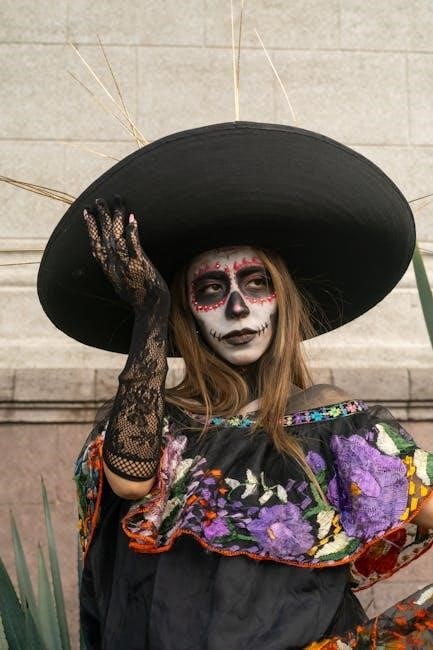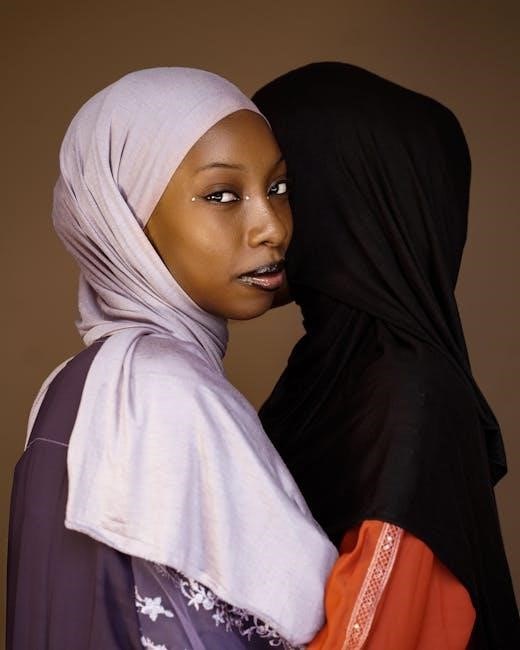
Black magick‚ often associated with dark‚ malevolent practices‚ involves harnessing supernatural forces for selfish or harmful ends. Its cultural significance varies widely across societies.
1.1 Definition and Overview
Black magick refers to the practice of harnessing supernatural forces for malevolent or selfish purposes‚ often involving dark rituals and forbidden knowledge. It is distinct from benevolent magic‚ focusing on power‚ control‚ and transgression. Historically‚ it has been shrouded in mystery and fear‚ with practices varying across cultures. Despite its controversial nature‚ black magick remains a significant aspect of occult studies‚ sparking debates about ethics‚ religion‚ and societal norms. Its allure lies in its promise of empowerment and its challenge to conventional moral frameworks.
1.2 Historical Context
Black magick has deep roots in ancient civilizations‚ with practices like necromancy and demonic invocations documented in Greco-Roman and Mesopotamian texts. The Middle Ages saw it intertwined with heresy‚ as the Catholic Church condemned such practices as satanic. Renaissance-era grimoires further popularized black magick‚ blending Christian and pagan elements. Historical records reveal its persistence despite persecution‚ evolving through cultural influences and maintaining a secretive‚ feared status across centuries.
1.3 Cultural Significance
Black magick holds profound cultural significance‚ often symbolizing rebellion against societal norms. It appears in folklore‚ literature‚ and art‚ evoking both fear and fascination. In some traditions‚ it serves as a means of empowerment‚ while in others‚ it is viewed as a moral transgression. Its enduring presence in modern media and pop culture highlights its lasting impact on human imagination and belief systems‚ bridging ancient practices with contemporary interests.
Historical Origins of Black Magick
Black magick traces its roots to ancient civilizations‚ evolving through diverse cultural practices and beliefs. Its origins are intertwined with early religious and mystical traditions.
2.1 Ancient Civilizations and Black Magick
Ancient civilizations laid the groundwork for black magick‚ with practices rooted in mysticism and supernatural beliefs. The Islamic world‚ for instance‚ saw texts like Shams al-maārif detailing magical rituals. Similarly‚ Greco-Roman traditions explored dark incantations and demonic invocations. Egyptian magical papyri also reveal early spells for protection and manipulation. These ancient practices‚ often intertwined with religion‚ set the stage for later interpretations of black magick as a force for both good and evil‚ shaping its cultural and historical significance across diverse societies.
2.2 Medieval Europe and the Rise of Witchcraft
Medieval Europe witnessed a surge in witchcraft accusations‚ fueled by fear and religious zeal. The Catholic Church condemned black magick as heresy‚ leading to widespread witch hunts and trials. Thomas Waters’ Cursed Britain highlights how societal anxieties and disasters spurred beliefs in dark supernatural forces. This period solidified black magick’s association with evil‚ shaping its perception in Western culture. The witch trials and executions became a dark chapter‚ reflecting the era’s religious and social tensions‚ and influencing modern views on black magick’s historical roots.
2.3 African Diasporic Traditions and Black Magick
African diasporic traditions‚ such as Hoodoo and conjure‚ blend African‚ Indigenous‚ and European influences‚ forming unique spiritual practices. Hoodoo‚ as discussed in the video Black Magic Matters‚ serves as a source of empowerment and resistance for Black communities. These traditions emphasize ancestor reverence and natural healing‚ often misunderstood as black magick. They reflect resilience and cultural adaptation‚ preserving African spiritual heritage while evolving in new contexts. This fusion highlights the complexity of black magick’s cultural expressions and its enduring significance in diasporic identities.

Cultural and Religious Perspectives
Black magick intersects with religion‚ folklore‚ and modern pop culture‚ reflecting societal fears and fascinations. Its practices vary widely‚ shaped by cultural and religious contexts globally.
3.1 Black Magick in Religious Contexts
Black magick often exists in tension with organized religion‚ which frequently condemns it as heresy or evil. In many religious traditions‚ it is seen as a corruption of divine power‚ misused for selfish or malevolent purposes. For instance‚ in Christianity‚ black magick is associated with demonic influence‚ while in Islam‚ it is linked to jinn and dark spiritual forces. Some religions‚ however‚ incorporate elements of black magick into their practices‚ blurring the lines between sacred and profane. This duality reflects the complex‚ often contradictory nature of black magick in religious contexts.
3.2 Folklore and Mythology
Black magick is deeply intertwined with folklore and mythology‚ often depicted as a forbidden yet fascinating force. In many cultures‚ it is associated with malevolent spirits‚ curses‚ and supernatural beings. African diasporic traditions‚ for example‚ feature entities like the Loa‚ while European folklore includes tales of witches and dark pacts. Middle Eastern myths reference jinn and their manipulation through black magick. These stories reflect societal fears and moral lessons‚ illustrating the dual nature of black magick as both a source of power and a harbinger of destruction.
3.3 Black Magick in Modern Pop Culture
Black magick captivates modern pop culture‚ appearing in films‚ TV shows‚ and literature. Series like Stranger Things and The Chilling Adventures of Sabrina feature dark magic rituals and supernatural themes. Movies such as The Craft and Hereditary explore its allure and dangers. Music artists also draw inspiration‚ with themes of mysticism and power. These portrayals often blend folklore with contemporary narratives‚ reflecting both fascination and fear. Black magick’s presence in media highlights its enduring influence on storytelling and cultural imagination‚ making it a timeless and universal theme.
Practices and Rituals
Black magick involves rituals like curses‚ divination‚ and summoning‚ often using tools such as spellbooks‚ herbs‚ and talismans. Practices vary widely‚ sparking ethical debates.

4.1 Common Rituals and Ceremonies
Black magick rituals often involve curses‚ divination‚ and summoning‚ utilizing tools like spellbooks‚ herbs‚ and talismans; Ceremonies may include chants‚ symbolic gestures‚ and offerings to dark forces. Protection rituals‚ such as casting circles‚ are also common to safeguard practitioners. These practices are deeply rooted in tradition and vary across cultures‚ reflecting diverse beliefs and objectives. Ethical debates surround these rituals‚ as they are often associated with harm or manipulation‚ sparking controversy within both practitioners and critics alike.
4.2 Tools and Materials Used
Black magick practices often employ specific tools and materials‚ such as spellbooks‚ herbs‚ talismans‚ and ritualistic symbols. These items are believed to enhance magical effects and provide protection. Herbs like wormwood and sage are used for purification and divination‚ while talismans serve as focal points for intent. Ritualistic symbols‚ such as pentacles and hexagrams‚ are drawn from ancient traditions. Grimoires and ancient manuscripts often detail these tools‚ emphasizing their cultural and historical significance in black magick rituals. Their use varies widely‚ reflecting diverse traditions and practitioner beliefs.
4.3 Ethical Considerations
Black magick raises significant ethical debates due to its association with harm and manipulation. Practitioners often grapple with the moral implications of using supernatural forces for selfish or destructive purposes. The potential for harm to others or oneself is a central concern‚ leading some to emphasize the importance of consent and ethical intent. Many traditions stress the responsibility to avoid causing unnecessary suffering‚ while others argue that the ends justify the means. The ethical landscape of black magick remains complex‚ reflecting diverse cultural and philosophical perspectives on power and morality.
Psychological and Sociological Impact
Belief in black magick deeply influences mental states‚ often inducing fear or paranoia. Societies frequently stigmatize practitioners‚ fostering isolation and reinforcing negative stereotypes.
5.1 Belief Systems and Perceptions
Belief in black magick varies widely‚ often reflecting cultural and religious values. Many perceive it as a malevolent force‚ evoking fear and mistrust. Historically‚ societies have linked black magick to moral corruption‚ viewing practitioners as outcasts. Psychological studies suggest that belief in such practices can lead to heightened anxiety and paranoia. In some cultures‚ however‚ black magick is seen as a means of empowerment or resistance‚ challenging societal norms. These contrasting perceptions highlight its complex role in shaping human behavior and societal dynamics across different eras and regions.
5.2 Social Stigma and Fear
Black magick often carries significant social stigma‚ fostering fear and mistrust. Historically‚ its practice has led to persecution‚ with societies viewing it as a threat to moral order. Fear of the unknown drives this stigma‚ as many associate black magick with malevolence and chaos. This fear has fueled witch hunts and violence‚ marginalizing practitioners. Even today‚ the stigma persists‚ influencing popular culture and public perception; The emotional and psychological impact of such fear can be profound‚ shaping both individual and collective attitudes toward black magick and its practitioners.
5.3 Mental Health Implications
The belief in and practice of black magick can have profound mental health implications. Fear of curses or supernatural retribution may lead to anxiety‚ paranoia‚ and psychological distress. Historically‚ accusations of black magick have caused trauma‚ isolation‚ and even mental breakdowns. Modern studies suggest that obsessive beliefs in dark magic can exacerbate conditions like depression or PTSD. Conversely‚ some practitioners report empowerment‚ but the duality of its impact highlights the complex interplay between belief systems and mental well-being.

Protection and Countering Black Magick
Protective rituals‚ cleansing ceremonies‚ and spiritual practices are employed to counter black magick. These methods aim to neutralize negative energies and restore balance‚ ensuring safety and well-being.
6.1 Methods of Protection
Protective methods against black magick include cleansing rituals‚ such as smudging with herbs or using sacred water‚ to purify spaces and individuals. Spiritual practices like meditation and prayer can strengthen personal defenses. Wearing or carrying protective symbols‚ such as talismans or amulets‚ is believed to repel negative energies. Additionally‚ setting boundaries through visualization or chants can create a shield against malevolent forces. These practices aim to restore balance and safeguard against potential harm‚ emphasizing the importance of mental‚ emotional‚ and spiritual resilience.

6.2 Cleansing and Purification Rituals
Cleansing and purification rituals are essential for removing negative energies and protecting against black magick. Common practices include smudging with herbs like sage or sweetgrass‚ which are believed to purify spaces and individuals. Sacred water‚ such as holy water or moonwater‚ is often used for cleansing. Rituals may also involve burning incense or reciting specific chants to drive out malevolent forces. These practices aim to restore balance‚ promote healing‚ and create a protective barrier against dark energies‚ ensuring a safe environment for spiritual well-being.
6.3 Case Studies of Successful Countermeasures
Historical accounts reveal effective countermeasures against black magick‚ often involving spiritual and cultural practices. In medieval Europe‚ mirrors were used to reflect negative energies back to their source. Similarly‚ African diasporic traditions employed protective symbols like the hexagram to ward off evil. Modern practitioners emphasize cleansing rituals‚ such as smudging with sage‚ to purify spaces. Community support and skilled practitioners also play a crucial role in combating dark magic‚ highlighting the importance of balance between physical and spiritual defenses to ensure lasting protection and harmony.
Historical Texts and Sources
Key texts like the 13th-century Shams al-maārif and Anglosaxon leechbooks provide insights into black magick practices‚ blending magic with spiritual and medicinal knowledge across cultures and eras.
7.1 Notable Grimoires and Spellbooks
Notable grimoires like the Shams al-maārif and Anglosaxon leechbooks offer deep insights into black magick rituals and spells. These texts‚ often blending magic with spirituality‚ have historically been sought after for their power. Modern PDFs and e-books‚ such as those detailing Hoodoo practices‚ provide accessible versions of these ancient works‚ preserving their cultural and mystical significance for contemporary practitioners. These sources remain vital for understanding the evolution of black magick across centuries and cultures.
7.2 Ancient Manuscripts and Scrolls
Ancient manuscripts and scrolls‚ such as the 13th-century Shams al-maārif‚ reveal intricate details of black magick practices. These texts often blend spiritual and mystical elements‚ offering insights into rituals‚ incantations‚ and symbolic practices. Scrolls from various cultures‚ including African diasporic traditions‚ highlight the diversity of black magick. Many of these manuscripts are now digitized as PDFs‚ preserving their historical significance and making them accessible for modern study and research into the origins and evolution of black magick.
7.3 Modern Publications and PDF Resources
Modern publications on black magick offer in-depth explorations of its practices and cultural significance. Notable works like Cursed Britain and Black Magic Matters provide historical and contemporary insights. PDF resources‚ such as digitized grimoires and academic articles‚ are widely available online‚ making black magick studies accessible. These materials often blend historical context with modern interpretations‚ catering to both scholars and enthusiasts. The rise of e-books and PDFs has democratized access to knowledge on black magick‚ fostering a global community of learners and practitioners.
Digital Age and Black Magick
The digital age has transformed black magick‚ with online communities‚ e-books‚ and PDF resources making ancient practices accessible. Cybersecurity concerns and ethical debates persist.
8.1 Online Communities and Forums
Online communities and forums have become hubs for discussing black magick‚ with platforms like Reddit’s r/MedievalHistory and r/AskHistorians exploring historical and cultural aspects. These spaces foster debates on practices‚ ethics‚ and historical contexts‚ such as early medieval demonology and witchcraft. Resources like the Yale University Press blog and HowStuffWorks provide insights into black magic’s evolution‚ while PDFs and e-books on platforms like JSTOR and Oxford Academic offer academic perspectives. This digital accessibility has democratized knowledge‚ sparking both fascination and ethical concerns about black magick’s modern relevance.
8.2 E-books and PDF Availability
E-books and PDFs on black magick are widely accessible‚ offering insights into its history‚ rituals‚ and cultural significance. Titles like Cursed Britain by Thomas Waters and Black Magic Matters provide detailed explorations of witchcraft and its modern relevance. Platforms like JSTOR‚ Google Books‚ and Oxford Academic host numerous PDF resources‚ including academic journals and historical manuscripts. These digital materials cater to both scholars and enthusiasts‚ making in-depth research on black magick more accessible than ever before.
8.3 Cybersecurity Concerns
The rise of digital black magick resources has introduced cybersecurity risks. Downloading PDFs from unverified sources can expose users to malware and phishing attacks. Personal data and devices may be compromised‚ especially when accessing niche or occult content; Users are advised to verify sources and use antivirus software to mitigate these risks. Despite precautions‚ the anonymous nature of online interactions heightens vulnerabilities‚ particularly for those seeking rare or ancient texts.

Academic and Scholarly Perspectives
Scholars examine black magick through interdisciplinary lenses‚ balancing empirical research with mystical traditions‚ sparking debates on its cultural and historical significance in academic circles.
9.1 University Studies and Research
Universities worldwide have initiated studies on black magick‚ exploring its historical‚ cultural‚ and psychological dimensions. Institutions like Yale and Oxford have published extensive research‚ analyzing its evolution and societal impact. Scholars delve into ancient texts‚ folklore‚ and modern practices‚ offering interdisciplinary perspectives. These studies often highlight the ethical debates surrounding black magick‚ bridging the gap between academic inquiry and mystical traditions. Such research provides a balanced view‚ acknowledging both the fear and fascination it inspires across cultures and time.
9.2 Expert Opinions and Theories
Experts and scholars offer diverse perspectives on black magick‚ blending historical analysis with contemporary theories. Historians like Thomas Waters highlight its enduring presence in modern societies‚ while philosophers explore its ethical implications. Some theorists distinguish black magick from dark magic‚ emphasizing intent and cultural context. Others‚ like those from Oxford Academic‚ examine its evolution through religious and philosophical frameworks. These expert opinions reveal black magick as a complex‚ multifaceted practice‚ reflecting both fear and fascination across cultures and time.
9.3 Interdisciplinary Approaches
Interdisciplinary approaches to black magick integrate insights from history‚ anthropology‚ sociology‚ and psychology. Historians trace its evolution across cultures‚ while anthropologists study its role in rituals and belief systems. Sociologists examine its impact on communities and power dynamics. Psychologists explore its influence on mental health and perception. This holistic approach provides a deeper understanding of black magick’s complexities‚ revealing its cultural‚ psychological‚ and social dimensions. Such studies bridge academic gaps‚ offering a nuanced perspective on its significance and practices.

Concluding Thoughts
Black magick’s enduring presence reflects its cultural‚ psychological‚ and historical significance‚ offering insights into human fears‚ desires‚ and the pursuit of power across centuries.
10.1 Summary of Key Points
Black magick‚ rooted in ancient practices‚ has evolved across cultures‚ reflecting societal fears and desires. Its historical significance spans from medieval witchcraft to modern spiritual movements. Practices involve rituals‚ tools‚ and ethical debates‚ while psychological impacts include stigma and mental health concerns. Cultural perceptions vary‚ with some viewing it as empowerment and others as malevolence. Modern times see its influence in pop culture and digital communities‚ alongside academic studies exploring its persistence and relevance in contemporary society.
10.2 Future Directions and Research
Future research on black magick should explore its intersection with technology‚ such as digital rituals and cybersecurity risks. Interdisciplinary studies combining anthropology‚ psychology‚ and sociology could deepen understanding of its cultural and psychological impacts. Additionally‚ examining the role of black magick in modern spiritual movements and its ethical implications remains crucial. Scholars should also investigate how global connectivity influences its evolution‚ ensuring a balanced perspective that respects diverse traditions while addressing misconceptions and stigma surrounding its practice.
10.3 Final Reflections
Black magick remains a complex and controversial topic‚ blending ancient traditions with modern interpretations. Its historical roots in fear and mysticism continue to shape perceptions‚ often fueling both fascination and stigma. While some view it as a tool for empowerment‚ others see it as a source of harm. Ethical debates persist‚ highlighting the need for respectful dialogue. As society evolves‚ understanding black magick requires balancing historical context with contemporary perspectives‚ fostering a nuanced appreciation for its cultural and psychological significance.

References and Further Reading

Key texts include Cursed Britain by Thomas Waters and Black Magic by Timothy J. McMillan. JSTOR and Yale University Press offer extensive resources for deeper exploration.
- Waters‚ T. (2023). Cursed Britain: A History of Witchcraft and Black Magic in Modern Times. Yale University Press.
- McMillan‚ T.J. (1994). Black Magic: Witchcraft‚ Race‚ and Resistance in Colonial New England. Journal of Black Studies.
- JSTOR: Black Magic in Modern Times and related academic articles.
11.1 Academic Journals and Books
Scholarly resources on black magick include Cursed Britain: A History of Witchcraft and Black Magic in Modern Times by Thomas Waters and Black Magic: Witchcraft‚ Race‚ and Resistance in Colonial New England by Timothy J. McMillan. Journals like the Journal of Black Studies and Oxford Academic provide in-depth analyses. These texts offer historical and cultural insights‚ exploring the persistence of black magick in various societies and its intersection with religion‚ race‚ and power dynamics.

- Waters‚ T. (2023). Cursed Britain; Yale University Press.
- McMillan‚ T.J. (1994). Black Magic. Journal of Black Studies.
11.2 Online Resources and Websites
Online resources offer extensive insights into black magick‚ with platforms like JSTOR and Yale Scholarship Online providing access to academic articles and books. Websites such as HowStuffWorks and Oxford Academic feature detailed explanations of rituals‚ cultural significance‚ and historical contexts. Additionally‚ forums like Reddit’s r/AskHistorians and r/MedievalHistory discuss black magick’s evolution and societal impact. These digital sources cater to both scholars and casual learners‚ offering a wealth of information on the subject.
- JSTOR: Academic articles on black magick history.
- HowStuffWorks: Explains myths and cultural significance;
- Reddit: Community discussions on historical and modern practices.
11.3 Recommended PDFs and E-books
Several PDFs and e-books provide in-depth exploration of black magick‚ offering historical‚ cultural‚ and practical insights. Notable works include “Cursed Britain” by Thomas Waters‚ which examines modern witchcraft‚ and “Shams al-maārif‚” a 13th-century Islamic text on magic. These resources cover rituals‚ cultural significance‚ and historical contexts‚ making them invaluable for researchers and enthusiasts alike. Many are available on platforms like Google Scholar‚ JSTOR‚ and independent author websites‚ ensuring accessibility for those seeking comprehensive understanding.